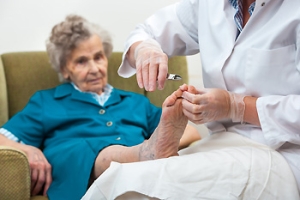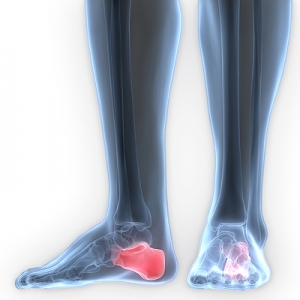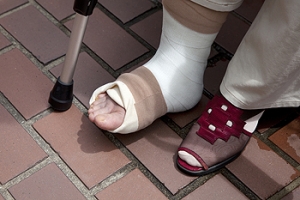
Working on Your Feet
Foot care is important regardless of your profession, but those who work on their feet must pay special attention. Bunions, calluses, blisters, and plantar warts are just a few of the many conditions that can arise after standing all day. While painful at their worst, these conditions can easily be avoided with the right foot care. This includes both appropriate footwear and proper posture—important elements that affect the health of your feet.
Choosing appropriate footwear means choosing a shoe that has a negative heel. This means that the heel is slightly lower than the ball of your foot, which places less of a strain. If you have a profession that requires you to be on your feet all day, investing in a pair of high-quality shoes is pertinent. High-quality shoes can be purchased from a respected manufacturer that emphasizes foot care and foot health.
Despite the regularity of wearing shoes, the feet are naturally not designed to be enclosed. Regular “barefoot” time for your feet can be beneficial for foot health. Among other methods, allowing your feet to breathe can help alleviate the pain and pressure your feet may be experiencing from being on your feet all day.
Simple foot exercises and yoga positions can help improve both the health and function of your feet. Active foot exercises that create movement will stimulate your foot’s blood flow and circulation, and yoga positions that place your feet flat onto the floor will stretch out their muscles. Yoga is particularly beneficial for your Achilles tendon and calf muscles, which are areas that can become especially problematic if not taken care of. Foot exercises and yoga positions can be easily performed every day at virtually any location and any time; whether it is at the office, at the gym, or at home right before you go to bed. Simple stretching can increase your foot health by miles.
The foot pain you experience after lengthy hours working on your feet may seem inevitable and unavoidable; in reality, however, that is not the case. Wearing proper footwear and performing simple foot exercises and stretches can help ease foot pain and allow you to truly avoid frustrating foot problems.
Your feet can easily be kept healthy with some education and a little effort. Pain that begins at the feet can eventually affect the whole body. Begin taking care of your feet now!
Specific Foot Stretches May Help Plantar Fasciitis
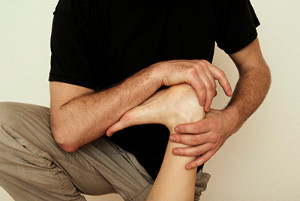 A common foot condition that is known as plantar fasciitis may produce severe pain and discomfort in some patients. It is defined as an inflammation of the plantar fascia and this is the tissue that is located on the bottom of the foot and connects the heel to the toes. The pain is generally felt in the heel of the foot, and it may tend to make daily activities that require mobility difficult to perform. Research has shown calf muscles, which are tight may possibly contribute to the discomfort plantar fasciitis may generate. There are specific stretches that can be practiced, which may aid in achieving a moderate level of relief. These may include standing with your palms flat against a wall while bending one leg forward and keeping the other leg straight while the the heel lies flat on the floor. This stretch can be held for several seconds, then repeated on the opposite side. Additionally, the plantar fascia may be adequately stretched while rolling your foot on a tennis ball, a foam roller, or a frozen water bottle. If you are afflicted with plantar fasciitis, it is advised to seek the counsel of a podiatrist who can properly treat this condition.
A common foot condition that is known as plantar fasciitis may produce severe pain and discomfort in some patients. It is defined as an inflammation of the plantar fascia and this is the tissue that is located on the bottom of the foot and connects the heel to the toes. The pain is generally felt in the heel of the foot, and it may tend to make daily activities that require mobility difficult to perform. Research has shown calf muscles, which are tight may possibly contribute to the discomfort plantar fasciitis may generate. There are specific stretches that can be practiced, which may aid in achieving a moderate level of relief. These may include standing with your palms flat against a wall while bending one leg forward and keeping the other leg straight while the the heel lies flat on the floor. This stretch can be held for several seconds, then repeated on the opposite side. Additionally, the plantar fascia may be adequately stretched while rolling your foot on a tennis ball, a foam roller, or a frozen water bottle. If you are afflicted with plantar fasciitis, it is advised to seek the counsel of a podiatrist who can properly treat this condition.
Stretching the feet is a great way to prevent injuries. If you have any concerns with your feet consult with Dr. Lee R. Stein from Lake Shore Foot & Ankle, PC. Our doctor will assess your condition and provide you with quality foot and ankle treatment.
Stretching the Feet
Being the backbone of the body, the feet carry your entire weight and can easily become overexerted, causing cramps and pain. As with any body part, stretching your feet can serve many benefits. From increasing flexibility to even providing some pain relief, be sure to give your feet a stretch from time to time. This is especially important for athletes or anyone performing aerobic exercises, but anyone experiencing foot pain or is on their feet constantly should also engage in this practice.
Great ways to stretch your feet:
- Crossing one leg over the others and carefully pull your toes back. Do 10-20 repetitions and repeat the process for each foot
- Face a wall with your arms out and hands flat against the wall. Step back with one foot and keep it flat on the floor while moving the other leg forward. Lean towards the wall until you feel a stretch. Hold for 30 seconds and perform 10 repetitions for each foot
- Be sure not to overextend or push your limbs too hard or you could risk pulling or straining your muscle
Individuals who tend to their feet by regular stretching every day should be able to minimize foot pain and prevent new problems from arising.
If you have any questions, please feel free to contact one of our offices located in Chicago, Highland Park, and Uptown, IL . We offer the newest diagnostic and treatment technologies for all your foot care needs.
Stretching Your Feet
Debilitating foot pain is a problem for many people. But just as stretching the torso can help alleviate back pain, stretching the feet can also help mend existing foot problems and prevent future ones.
The feet, as the body’s foundation, carry the body’s entire weight and can get easily strained from overexertion. Persistent sharp pain and cramping in the feet are often common concerns. Foot pain and foot problems can be due to any number of causes, and in many cases pain may be eased without medication or doctor visits. It is always a good idea, however, to first rule out any serious medical issues with a physician.
Stretching can help relax the feet and alleviate pain, but is especially important before heavy aerobic exercise. Stretching before such activities can help you avoid experiencing painful cramps or strained foot muscles. Stretches should be performed slowly and deliberately without forceful pulling. The stretch should be held for several seconds before relaxing.
A great way to stretch out and loosen up the foot muscles while sitting is to cross one leg over the other and pull the toes carefully back without overextending. Start by resting the left ankle on the right knee. With the left hand, gently flex the left foot by pulling back on the toes. Do not pull too hard; just hard enough to feel the stretch in the arch of the foot. Then point the toes of the left foot as far as you can. Rotate the motion of pointing with pulling back on the toes. This should relax and stretch the muscles on the bottom and the top of the foot. Doing this stretch ten to twenty times should bring relief. Repeat the whole process for the other foot by resting the right ankle on the left knee.
A stretch that focuses on the often injured Achilles tendon involves standing and facing a wall with your arms out and hands flat against the wall. Step back with one foot, keeping it flat against the floor. Move the other leg forward and lean toward the wall. You should feel a stretch through the back of your leg and your Achilles tendon, but do not push yourself too much. Stop when you feel a stretching sensation, and hold for 30 seconds. Ten repetitions may be done for each foot.
Stretching the feet is important for athletes or those performing aerobic exercise, but it can also help anyone with foot pain caused by poor footwear, plantar fasciitis, or long hours standing and walking. Individuals who tend to their feet by regularly stretching every day should be able to minimize foot pain and prevent new problems from arising.
Wounds That Don't Heal Need to Be Checked
Proper Foot Care May Prevent Certain Foot Conditions from Occurring
 Many people are aware of how having healthy feet can benefit the overall health of the body. As the aging process occurs, it may become difficult to perform daily foot inspections, which may prevent specific foot conditions from occurring. When the feet are properly looked after, improved muscle strength may be noticed, walking may become easier, and having stronger feet may prevent unnecessary falling from occurring. When practicing certain preventative measures, foot ailments that may include bunions and fungal infections of the feet or toenails may be avoided. Additionally, frequent soaking of the feet may aid in properly trimming the toenails and may provide relief if an ingrown toenail is present. If you would like additional information about the importance of properly caring for elderly feet, it is advised to seek the counsel of a podiatrist.
Many people are aware of how having healthy feet can benefit the overall health of the body. As the aging process occurs, it may become difficult to perform daily foot inspections, which may prevent specific foot conditions from occurring. When the feet are properly looked after, improved muscle strength may be noticed, walking may become easier, and having stronger feet may prevent unnecessary falling from occurring. When practicing certain preventative measures, foot ailments that may include bunions and fungal infections of the feet or toenails may be avoided. Additionally, frequent soaking of the feet may aid in properly trimming the toenails and may provide relief if an ingrown toenail is present. If you would like additional information about the importance of properly caring for elderly feet, it is advised to seek the counsel of a podiatrist.
Proper foot care is something many older adults forget to consider. If you have any concerns about your feet and ankles, contact Dr. Lee R. Stein from Lake Shore Foot & Ankle, PC. Our doctor can provide the care you need to keep you pain-free and on your feet.
The Elderly and Their Feet
As we age we start to notice many changes in our body, but the elder population may not notice them right away. Medical conditions may prevent the elderly to take notice of their foot health right away. Poor vision is a lead contributor to not taking action for the elderly.
Common Conditions
- Neuropathy – can reduce feeling in the feet and can hide many life-threatening medical conditions.
- Reduced flexibility – prevents the ability of proper toenail trimming, and foot cleaning. If left untreated, it may lead to further medical issues.
- Foot sores – amongst the older population can be serious before they are discovered. Some of the problematic conditions they may face are:
- Gouging toenails affecting nearby toe
- Shoes that don’t fit properly
- Pressure sores
- Loss of circulation in legs & feet
- Edema & swelling of feet and ankles
Susceptible Infections
Diabetes and poor circulation can cause general loss of sensitivity over the years, turning a simple cut into a serious issue.
If you have any questions please feel free to contact one of our offices located in Chicago, Highland Park, and Uptown, IL . We offer the newest diagnostic and treatment technologies for all your foot and ankle needs.
Elderly and their Feet
While proper foot care is important for everybody, senior citizens have the tendency to be more susceptible to certain foot conditions. The elderly should therefore be well informed about any problems that may arise and about what they can do to properly avoid or treat them.
Some of the most common foot problems seniors are susceptible to include foot ulcers, ingrown toenails, fallen arches, and fungal nails. A foot ulcer is an open sore on the foot and can be a result of diabetes and decreased sensation in the feet. An ingrown toenail is defined as when the nail grows into the side of the toe. Fallen arches are indicated by the instep of the foot collapsing. A fungal nails is a condition that results in deformed and discolored toenails.
In order to avoid these conditions it is recommended that the feet be inspected by the patient on a regular basis. If these inspections are carried out routinely, there is a good likelihood that problems can be identified before they become severe, or can even be avoided altogether. If any abnormality is discovered, it is important that the individual consult a podiatrist for diagnosis and information on treatment options.
Proper foot hygiene is also important. Making sure that you always have clean, dry socks on can be a major deterrent to many different problems including bacterial infections, foot odor, and certain types of fungus. Wet feet are a major cause of many of these problems. If your socks get wet, it is important to change them. Walking around in wet socks may not only lead to various infections, but can irritate the skin and result in a number of various complications. Clean, dry feet are less likely to be affected by fungal and other infections.
As people age, the fat present on your feet begins to deteriorate. The protective nature of this fat keeps the feet healthy by providing a barrier between your bones and the ground. This also aids in giving the skin on the feet a certain amount of elasticity. This is one factor that causes elderly people to develop some serious foot issues. Foot moisturizers can be helpful to avoid certain problems associated with this. However, water-based moisturizers do not work as well for elderly people as they do for the young. Instead, it is more effective to use an emollient instead. An emollient is effective because it binds the water in the foot, keeping it from becoming absorbed too readily which will result in dry skin. Emollients also have a special property called occlusion, which provides a layer of oil on the skin. This layer prevents the foot from drying up and can be very effective in treating dry skin disorders. If you can keep the skin on your feet healthy, this will substantially reduce the number of foot problems you will encounter in old age.
Proper footwear is another way to keep feet healthy. Shoes that fit well and provide proper support help prevent ingrown toenails and fallen arches.
Certain medical conditions such as diabetes or poor blood circulation increase the risk for foot issues. For individuals with any of these conditions it is extremely important to conduct regular foot inspections to make sure that there are no sores or infections present.
Two Types of Heel Spurs
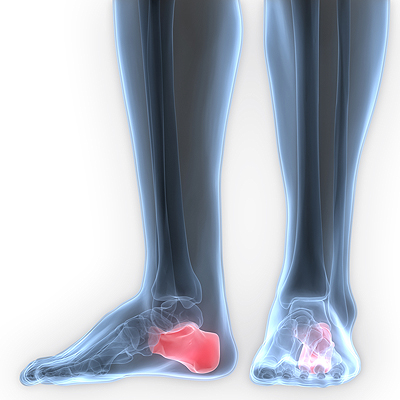 A condition that is known as a heel spur may present itself in two different categories. One of them is often referred to as heel spur syndrome and is characterized by bony protrusions that form on the bottom of the heel. They may look like a small hook and will grow toward the plantar fascia. This may develop as a result of repeated tearing of the heel bone lining, in addition to straining the ligaments and muscles of the foot. Patients may develop insertional Achilles tendonitis as a form of a heel spur, and this will typically occur where the heel bone connects to the Achilles tendon. If the Achilles tendon becomes irritated and inflamed, severe pain and discomfort may often accompany this condition. This type of heel spur may form as a result of decreased ankle motion and is known to develop gradually. If you are experiencing a heel spur, it is advised to seek the expert knowledge of a podiatrist who can properly treat this condition.
A condition that is known as a heel spur may present itself in two different categories. One of them is often referred to as heel spur syndrome and is characterized by bony protrusions that form on the bottom of the heel. They may look like a small hook and will grow toward the plantar fascia. This may develop as a result of repeated tearing of the heel bone lining, in addition to straining the ligaments and muscles of the foot. Patients may develop insertional Achilles tendonitis as a form of a heel spur, and this will typically occur where the heel bone connects to the Achilles tendon. If the Achilles tendon becomes irritated and inflamed, severe pain and discomfort may often accompany this condition. This type of heel spur may form as a result of decreased ankle motion and is known to develop gradually. If you are experiencing a heel spur, it is advised to seek the expert knowledge of a podiatrist who can properly treat this condition.
Heel spurs can be incredibly painful and sometimes may make you unable to participate in physical activities. To get medical care for your heel spurs, contact Dr. Lee R. Stein from Lake Shore Foot & Ankle, PC. Our doctor will do everything possible to treat your condition.
Heels Spurs
Heel spurs are formed by calcium deposits on the back of the foot where the heel is. This can also be caused by small fragments of bone breaking off one section of the foot, attaching onto the back of the foot. Heel spurs can also be bone growth on the back of the foot and may grow in the direction of the arch of the foot.
Older individuals usually suffer from heel spurs and pain sometimes intensifies with age. One of the main condition's spurs are related to is plantar fasciitis.
Pain
The pain associated with spurs is often because of weight placed on the feet. When someone is walking, their entire weight is concentrated on the feet. Bone spurs then have the tendency to affect other bones and tissues around the foot. As the pain continues, the feet will become tender and sensitive over time.
Treatments
There are many ways to treat heel spurs. If one is suffering from heel spurs in conjunction with pain, there are several methods for healing. Medication, surgery, and herbal care are some options.
If you have any questions feel free to contact one of our offices located in Chicago, Highland Park, and Uptown, IL . We offer the latest in diagnostic and treatment technology to meet your needs.
How to Treat Heel Spurs
Heel spurs are calcium deposits that cause bone protrusions on the heel bone. Heel spurs are usually associated with plantar fasciitis, which occurs when the plantar fasciitis in the foot becomes inflamed. Typically, heel spurs don’t cause any symptoms. However, they can produce chronic or intermittent heel pain. Those who have had the condition often describe the irritation as a stabbing pain.
There are risk factors that may make you more likely to develop heel spurs. People who have abnormal walking gaits, run and jog on hard surfaces, are obese, or wear poorly fitting shoes are more likely to develop heel spurs.
Fortunately, there are precautions you can take to avoid developing heel spurs. One of the best ways to do this is by wearing well-fitting shoes with shock-absorbent soles. Another preventative technique is to choose running shoes if you plan on running, and walking shoes if you plan on walking. Shoes are made for different activities and it is important to research a shoe before you purchase a pair.
The pain associated with heel spurs often decreases the more you walk. However, a recurrence of pain after an extended period of rest or walking is likely to occur with this condition. Those with severe heel spur pain may opt to go the surgical route for treatment. However, more than 90% of those with the condition get better without surgical treatment. If you have a heel spur and want to know if surgery is right for you, you should go to your podiatrist and he or she will be able to conduct a pre-surgical test or exam to determine if you are an optimal candidate for surgery.
How to Prevent Foot Injuries
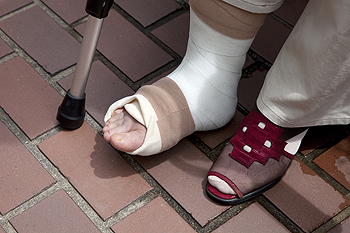 People who enjoy the sport of running or who participate in jumping activities may know the importance of preventing injuries that may occur to the foot and ankle. Research has shown when the muscles are properly stretched and warmed up prior to engaging in sporting activities, the possibility of incurring this type of injury may be diminished. It is generally beneficial to wear shoes that are designed for your foot structure, and this may aid in maintaining stability and comfort. When the heels of the shoes wear out from frequent running, replacement should occur as quickly as possible, and this may prevent unwanted injuries from occurring. If a minor injury should happen, resting the foot for the proper amount of time may aid in resuming your sport of choice. If you have endured an injury to the foot or ankle, it is suggested to speak with a podiatrist, so proper treatment options can be discussed.
People who enjoy the sport of running or who participate in jumping activities may know the importance of preventing injuries that may occur to the foot and ankle. Research has shown when the muscles are properly stretched and warmed up prior to engaging in sporting activities, the possibility of incurring this type of injury may be diminished. It is generally beneficial to wear shoes that are designed for your foot structure, and this may aid in maintaining stability and comfort. When the heels of the shoes wear out from frequent running, replacement should occur as quickly as possible, and this may prevent unwanted injuries from occurring. If a minor injury should happen, resting the foot for the proper amount of time may aid in resuming your sport of choice. If you have endured an injury to the foot or ankle, it is suggested to speak with a podiatrist, so proper treatment options can be discussed.
Foot and ankle trauma is common among athletes and the elderly. If you have concerns that you may have experienced trauma to the foot and ankle, consult with Dr. Lee R. Stein from Lake Shore Foot & Ankle, PC. Our doctor will assess your condition and provide you with quality foot and ankle treatment.
Foot and ankle trauma cover a range of injuries all over the foot; common injuries include:
- Broken bones
- Muscle strains
- Injuries to the tendons and ligaments
- Stress fractures
Symptoms
Symptoms of foot and ankle injuries vary depending on the injury, but more common ones include:
- Bruising
- Inflammation/ Swelling
- Pain
Diagnosis
To properly diagnose the exact type of injury, podiatrists will conduct a number of different tests. Some of these include sensation and visual tests, X-rays, and MRIs. Medical and family histories will also be taken into account.
Treatment
Once the injury has been diagnosed, the podiatrist can than offer the best treatment options for you. In less severe cases, rest and keeping pressure off the foot may be all that’s necessary. Orthotics, such as a specially made shoes, or immobilization devices, like splints or casts, may be deemed necessary. Finally, if the injury is severe enough, surgery may be necessary.
If you have any questions, please feel free to contact one of our offices located in Chicago, Highland Park, and Uptown, IL . We offer the newest diagnostic and treatment technologies for all your foot care needs.






